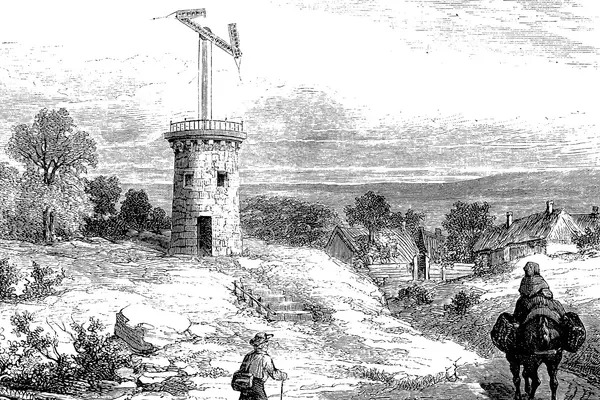In this blog post, we will delve into the intriguing world of semaphore telegraphy, a forgotten form of long-distance communication that played a crucial role before the advent of modern telecommunication systems. Semaphore telegraphy was a revolutionary method that allowed individuals to transmit messages across vast distances using signaling arms or flags.
Table of Contents
The Concept and Importance of Semaphore Telegraphy
Semaphore telegraphy involved the use of semaphore towers strategically placed across different regions. These towers would transmit messages through the positioning of signaling arms or flags, which conveyed various combinations and positions of signals. This system was instrumental in facilitating communication over long distances, enabling the exchange of information and news in a relatively efficient manner.
Before the rise of modern telecommunication systems, semaphore telegraphy played a pivotal role in long-distance communication. It revolutionized the way information was transmitted, enhancing the speed and efficiency of communication. It allowed people to relay messages, news, and instructions across vast distances, enabling trade, military communications, and diplomatic correspondence. Semaphore telegraphy bridged gaps and connected people in ways that were previously unimaginable.
The historical origins of semaphore telegraphy can be traced back to the 18th and 19th centuries when it gained widespread use. Notable figures and events associated with this communication method include Claude Chappe, who is credited with the development and popularization of semaphore telegraphy in France. His network of semaphore towers became the foundation for subsequent similar systems across Europe and beyond.
Semaphore telegraphy networks were established in various countries and regions, creating a web of interconnected communication lines. These networks relied on a series of strategically placed semaphore towers that allowed messages to be transmitted over long distances. However, maintaining and expanding these networks posed significant challenges, including the need for trained operators, weather-dependent limitations, and the need for ongoing infrastructure maintenance.
While semaphore telegraphy had undeniable advantages over other means of communication at the time, it also had limitations. One major drawback was its dependency on clear visibility between the towers for effective communication. Additionally, the semaphore system was limited in its ability to transmit complex messages and was vulnerable to misinterpretation due to operator error or external interference.
Despite its eventual decline with the emergence of more advanced telecommunication methods, semaphore telegraphy left a lasting legacy. Its decline was largely brought about by the rise of electrical telegraphy, which offered swift and reliable communication over great distances. However, the ingenuity and innovativeness of semaphore telegraphy should not be forgotten. Modern communication systems owe a debt of gratitude to the advancements made in the field of semaphore telegraphy.
In recent years, there has been a renewed interest and fascination surrounding the history of semaphore telegraphy. Instances of revival and study can be found, where individuals and organizations aim to preserve and rediscover the techniques and intricacies of this forgotten communication method. The relevance of semaphore telegraphy in modern technology and society lies not only in its historical significance but also in the enduring allure and curiosity it generates among enthusiasts and historians.
In conclusion, semaphore telegraphy represented a significant chapter in the history of communication, revolutionizing long-distance information exchange before the advent of modern telecommunication systems. Its importance cannot be overstated, as it facilitated trade, military communications, and diplomatic relations. Semaphore telegraphy demonstrated the ingenuity of its inventors, leaving a lasting legacy on modern communication systems. As we delve further into this forgotten world, it is crucial to appreciate the significance of semaphore telegraphy and the impact it had on shaping the way we communicate today.
Historical Background
Semaphore telegraphy has a rich and fascinating history that dates back to the late 18th century. Its origins can be traced to the French engineer Claude Chappe, who developed the first practical semaphore telegraph system. This system consisted of a series of towers equipped with movable arms that could be used to signal letters and numbers.
Chappe’s invention quickly gained popularity and was adopted by many countries in Europe and beyond. The semaphore telegraph network grew rapidly, with thousands of miles of telegraph lines being established during the 19th century.
One of the notable figures associated with semaphore telegraphy is Ignace Chappe, Claude’s younger brother, who played a crucial role in improving and expanding the system. Another important event in the history of semaphore telegraphy was the establishment of the first international telegraph line between France and England in 1803.
Semaphore telegraphy played a vital role in long-distance communication during its heyday. It allowed messages to be transmitted quickly over vast distances, revolutionizing the way information was exchanged. The system was particularly valuable for military purposes, as it enabled rapid communication between different army bases and forts.
How Semaphore Telegraphy Works
The semaphore system was a groundbreaking method of long-distance communication before modern telecommunication systems came into existence. It utilized signaling arms or flags to convey messages, allowing people to communicate over vast distances.
The semaphore system involved a network of semaphore towers placed strategically to ensure message transmission over long distances. These towers were equipped with mechanical arms or flags that could be positioned in various ways to represent different letters or words.
To transmit a message, an operator at one tower would position the signaling arm or flag to represent a specific letter or word. This position would then be observed by operators at neighboring towers, who would replicate the same position with their own signaling devices. This process would continue until the message reached its intended destination.
The significance of different positions and combinations of signals was crucial in semaphore telegraphy. Each position had a specific meaning, allowing operators to convey a wide range of messages. For example, a horizontal arm could represent the letter “A,” while a diagonal arm could indicate the letter “B.” By combining different positions, operators could effectively communicate words and sentences.
This system of visual communication offered advantages such as speed and simplicity. Messages could be transmitted quickly over long distances, allowing for efficient communication. The use of visual signals also eliminated the need for complex codes or language barriers, making it accessible to people of different backgrounds.
However, semaphore telegraphy also had its limitations. It heavily relied on clear visibility between towers, making it vulnerable to adverse weather conditions or obstructions. Additionally, it required a network of well-maintained towers and skilled operators, which proved to be costly and challenging to maintain in the long run.
While the semaphore system eventually declined with the advent of electrical telegraphy, its legacy still lives on. It paved the way for future developments in telecommunication and acted as a precursor to more advanced systems.
Today, semaphore telegraphy is being rediscovered and studied for its historical significance. It continues to captivate the curiosity of researchers and enthusiasts alike, who find value in preserving and understanding this forgotten world of communication. By appreciating the ingenuity and innovativeness of semaphore telegraphy, we gain a deeper understanding of the evolution of communication systems and the impact they have on our modern world.
Semaphore Telegraphy Networks
Semaphore telegraphy networks were established in various countries and regions during the 18th and 19th centuries, comprising a complex system of towers and signaling stations. These networks played a crucial role in facilitating long-distance communication, revolutionizing the way information was transmitted across vast distances.
The establishment of semaphore telegraphy networks was a significant undertaking that required meticulous planning and coordination. Towers were strategically placed at specific intervals, forming a network of communication hubs. Each tower housed an operator who would use signaling arms or flags to convey messages. The towers were typically located on high ground to ensure maximum visibility and were often spaced about 10 to 20 miles apart.
The role of semaphore towers in transmitting messages cannot be underestimated. These towering structures served as the backbone of the semaphore telegraphy network, allowing messages to be relayed from one tower to the next. As a signal was received, the operator would quickly replicate it using the signaling arms or flags and transmit it to the next tower in the network. This relay system enabled messages to travel great distances in a relatively short period.
However, maintaining and expanding these networks presented numerous challenges. One of the main obstacles was the constant need for skilled operators. Semaphore telegraphy required operators who were well-versed in the intricate system of signals and could quickly and accurately transmit messages. In many cases, a single mistake could lead to misinterpretation or confusion.
Another challenge was the vulnerability of the semaphore towers to adverse weather conditions and natural disasters. High winds, heavy rain, or even fog could obstruct the visibility of the signals, making communication difficult or impossible. Additionally, the maintenance of the towers was costly and time-consuming, requiring regular inspections and repairs.
Despite these challenges, semaphore telegraphy networks thrived for several decades, playing a vital role in long-distance communication. They enabled governments, military organizations, and commercial entities to transmit important information quickly and efficiently. However, with the advent of more advanced telecommunication systems, such as the electrical telegraph, semaphore telegraphy eventually became obsolete.
The establishment of semaphore telegraphy networks marked an essential milestone in the history of communication. These networks represented a significant leap forward, bringing distant corners of the world closer together. Although no longer in use, semaphore telegraphy network remains a testament to human ingenuity and innovation, and its legacy can still be seen in modern communication systems.
Advantages and Limitations
Semaphore telegraphy was a groundbreaking method of communication during the 18th and 19th centuries, offering several advantages over other means of communication at the time. One of the key advantages was its ability to transmit messages over long distances, enabling communication between distant locations that were otherwise inaccessible. This was particularly important in a time when modern telecommunication systems were yet to be developed.
The significance of semaphore telegraphy lay in its reliability and speed. Unlike other methods of communication, such as homing pigeons or horseback messengers, semaphore telegraphy allowed for almost instantaneous transmission of messages. This was crucial for military purposes, where quick and reliable communication was essential for coordinating troops and relaying important information.
Furthermore, semaphore telegraphy was not affected by geographical obstacles such as mountains or rivers, making it a preferred method for long-distance communication. Semaphore towers strategically placed along communication lines allowed for the swift transmission of messages, overcoming the limitations of other methods.
Despite its advantages, semaphore telegraphy did have its limitations and drawbacks. One of the main limitations was its reliance on clear visibility between the signaling stations. Bad weather, fog, or even simple obstructions like trees or buildings could disrupt the line of sight required for successful communication. This posed a significant challenge in maintaining uninterrupted communication, especially in regions prone to adverse weather conditions.
Another limitation was the complexity of the system itself. Semaphore telegraphy required skilled operators who were trained in interpreting and transmitting messages using the signaling arms or flags. The need for training and expertise made it a more exclusive method of communication, limiting its accessibility and widespread adoption.
When comparing semaphore telegraphy with other historical telecommunication methods like the electrical telegraph, it becomes evident that semaphore telegraphy was eventually surpassed by more advanced technologies. While semaphore telegraphy had its merits, the electrical telegraph offered faster transmission rates, greater reliability, and the ability to transmit messages over much longer distances. These advancements rendered semaphore telegraphy obsolete, leading to its decline.
Despite its eventual decline, the legacy of semaphore telegraphy can still be seen in modern communication systems. The principles of visual signaling and the importance of maintaining clear lines of sight continue to be relevant in technologies such as optical communication and even certain military applications. The ingenuity and innovativeness demonstrated by semaphore telegraphy should be commended, as it laid the foundation for the development of more advanced telecommunication methods that revolutionized how we communicate today.
Decline and Legacy
Semaphore telegraphy, once a revolutionary means of communication, eventually faced its decline for several reasons. As modern telecommunication systems began to emerge, the limitations of semaphore telegraphy became evident. The reliance on line of sight and the need for clear weather conditions made it impractical for long-distance communication in all types of weather. Additionally, the time-consuming nature of transmitting messages through semaphore towers became a hindrance in an era where speed and efficiency were becoming increasingly important.
As semaphore telegraphy faded into obscurity, a new form of communication took center stage: electrical telegraphy. This superior alternative made use of electrical signals to transmit messages rapidly over long distances, without the limitations of line of sight or weather conditions. The rise of electrical telegraphy marked the end of an era for semaphore telegraphy, rendering it obsolete.
Despite its decline, semaphore telegraphy left a lasting legacy in modern communication systems. The basic concept of transmitting information through visual signals laid the foundation for visual communication methods used today. Semaphore flags, for example, are still used in maritime navigation to convey messages between ships. The efficiency achieved by semaphore telegraphy networks has also influenced the development of modern telecommunication systems, emphasizing the importance of rapid transmission of information.
Overall, the decline of semaphore telegraphy can be seen as the natural progression of technology, as newer and more efficient methods emerged. While its significance may have faded over the years, there is still a fascination and curiosity surrounding this forgotten world. For those interested in the history of communication, semaphore telegraphy remains an immutable symbol of ingenuity and innovativeness. It serves as a reminder of the advancements made in communication technology and the continuous drive for faster and more efficient means of connecting people across the world.
Rediscovering Semaphore Telegraphy
Semaphore telegraphy, although largely forgotten today, has experienced a resurgence of interest in recent years. Researchers and enthusiasts alike have revived this once essential form of long-distance communication, shedding light on its intriguing history and technological innovation.
One such instance of semaphore telegraphy being studied is the Semaphore Tower in Plymouth, England. This tower, which was part of a larger network, was meticulously restored and preserved, allowing visitors to step back in time and experience the ingenious signaling system firsthand. The Semaphore Tower serves as a tangible reminder of the fascination and wonder surrounding the forgotten world of semaphore telegraphy.
Beyond preservation efforts, there has also been a growing interest in studying semaphore telegraphy from an academic perspective. Historians and communication experts have delved into the archives, unearthing forgotten documents and accounts that shed new light on the intricacies of this forgotten communication method. This renewed focus on semaphore telegraphy is a testament to its enduring relevance in the context of modern technology and society.
Semaphore telegraphy holds more than just historical significance; it offers valuable insight into the development of communication technologies. By understanding how semaphore telegraphy worked and the challenges it faced, we gain a deeper appreciation for the rapid advancements in telecommunication that we enjoy today. Semaphore telegraphy serves as a reminder that even the most rudimentary forms of communication laid the foundation for the sophisticated systems we use today.
In conclusion, semaphore telegraphy, once a vital means of long-distance communication, has been rediscovered and studied in recent years. The restoration of Semaphore Towers and the academic exploration of its history highlight the enduring fascination surrounding this forgotten world. Semaphore telegraphy’s relevance in the context of modern technology and society reminds us of the ingenuity and innovativeness of our predecessors in the field of communication.
Conclusion
In conclusion, semaphore telegraphy played a significant role in the history of communication. Developed in the late 18th century, this ingenious system allowed for long-distance communication before the advent of modern telecommunication systems. The concept of semaphore telegraphy involved the use of signaling arms or flags to convey messages, with different positions and combinations of signals holding significant meaning.
Semaphore telegraphy networks were established in various countries and regions, with semaphore towers serving as crucial transmission points. These networks faced many challenges, including the maintenance and expansion of the system. However, semaphore telegraphy had several advantages over other means of communication at the time, such as its speed and efficiency.
Despite its advantages, semaphore telegraphy had its limitations, which ultimately led to its decline. The rise of electrical telegraphy introduced a superior alternative that rendered semaphore telegraphy obsolete. Nonetheless, the legacy of semaphore telegraphy can still be seen in modern communication systems, and it continues to fascinate and intrigue enthusiasts and historians alike.
In recent years, there have been instances where semaphore telegraphy has been rediscovered and studied. This resurgence highlights the enduring allure and curiosity surrounding this forgotten world. The history and relevance of semaphore telegraphy in the context of modern technology and society are appreciated by those who recognize the ingenuity and innovativeness of this early communication method.
In summary, semaphore telegraphy was a vital aspect of communication history, bridging long distances and enabling messages to be transmitted efficiently in the past. Reflecting on the enduring allure and curiosity surrounding this forgotten world allows us to appreciate the past advancements and advancements to come. Semaphore telegraphy truly exhibits the ingenuity and innovativeness of human invention and reminds us of the significant progress made in the field of communication.




